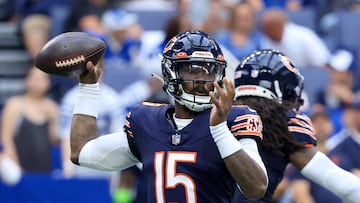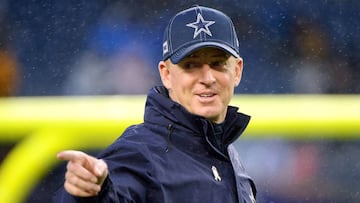NFL roster cuts: What happens next for the players who didn’t make the cut?
For most NFL fans, the rosters are just a list of names and we quickly forget about the ones who are cut. But what is life really like for them after that?

The NFL teams whittled down their rosters to the final 53 on Tuesday, after starting OTAs, minicamps, and training camps with 90 men. It happens every year, and for most of us, they are just a list of names. But what actually happens to the people who don’t make that final cut? For some, it’s just temporary. Players could be cut today and re-signed tomorrow. For others, it could mean uprooting their lives and the future they thought they’d have. And for some, particularly those with certain injuries, it means coming to terms with the fact that they may have to find a completely new career.
“Being an undrafted free agent, you kind of feel like you’re just kind of a camp body. And if they need to get rid of you, they get rid of you.”
What happens once an NFL player is cut?
Let’s start with the technical stuff. There are two possibilities for a player who is cut. It’s important to note the difference between being waived and being released. A player who is waived (only possible if that player has less than four accrued seasons in the league) will keep their contracts until they have gone through the waiver wire. A player who is released has their contract terminated and becomes a free agent. Any free agent is eligible to sign with the team’s practice squad (depending on experience), but let’s say the team has no intention at all of signing a player to their practice squad. What happens then?
How the cut is handled can be dramatically different depending on the team, coach, front line, etc. Former offensive lineman Jeff Olson was released a few different times from different teams, and provided us with some insight into just how different that experience can be.
The TCU alum from McKinney, Texas graduated in 2012 and had shoulder surgery shortly after. He made it to the New York Jets training camp that year, but was released before the regular season began. Since he was still recovering from surgery, he remained an undrafted free agent for the rest of the season. He was signed to a three-year deal by the Tampa Bay Buccaneers the following year, but released about seven or eight days later. Then, the Dallas Cowboys signed him on a two-year deal. Unfortunately, Olson suffered from a concussion, and was released by the Cowboys during the preseason. (He was later re-signed, but more on that later.) So, how did each team handle the cut? According to Olson, they were all a little bit different.
“Everybody thinks they’re gonna make the team, they’re gonna be a starter, they’re gonna wear that gold jacket, but I have a feeling that in the back of everybody’s minds, there’s a little piece that says, ‘hey, who knows?’”
“With the Buccaneers, it was very…I don’t want to say it was standoffish, but it was kind of, like, detached,” said Olson. He described that year in Tampa Bay as being extremely transactional, with players being shown in and out of camp on a consistent and regular basis, even throughout the regular season.
“I was, as any other player would be, confident in my abilities, and you can get the job done. But at the end of the day, each team and each coach wants a certain type of player and me being an undrafted free agent, you kind of feel like you’re just kind of a camp body. And if they need to get rid of you, they get rid of you.”
With the Jets, Olson said the way they went about releasing him was a lot more personalized, which he appreciated.
“It was really interesting because with the offensive line coach - he sat me down and said, ‘I think you’re a really good player, this is where I think you need to improve, this is where you do really great, keep working’”.
In the NFL, cuts like this can happen to any player at any time. It can be difficult to get too comfortable anywhere. At the same time that every player feels like they will be the one who defies the low odds of making it in the league after college, they are also aware that things could change in a split second.
“Everybody thinks they’re gonna make the team, they’re gonna be a starter, they’re gonna wear that gold jacket, but I have a feeling that in the back of everybody’s minds, there’s a little piece that says, ‘hey, who knows? Anything could happen. I could go and break my leg.’ Or you could be like me, you could go and get a really bad concussion. And then it’s just done. And it’s nothing you did. It just happens.”
Injury-related decisions in the NFL
When Olson was signed to the Cowboys, it was not long before he suffered from what he described as a “pretty severe concussion”. Unable to practice with the team, he had a lot of alone time to think and scroll on Twitter. He would see news of the Cowboys bringing in players at his position and wonder what that meant for him. He started to get the feeling that a cut was a real possibility for him. As his symptoms subsided and he was cleared to practice, he was taken off injured reserve…and then released. This time, though, it was head coach Jason Garrett who delivered the news to Olson personally.
“It was over pretty quick and then after that, I went to my room, got my stuff, got on a plane later that day, sat in a middle seat from LAX to Dallas, and that was that.”
“I hadn’t really had an in-depth conversation with him, anything other than in-passing before. But he was super kind about it. He was like ‘hey, this is the situation, it’s a bummer. You’re a great player, keep working. We’ll see what happens in the future.’ That could be something that he says to everybody.”

“It was a tough time for me, but having that kind of one-on-one experience was really cool after - again, not calling the previous regime in Tampa Bay cold - but this was a much different situation than I’d had before. So I appreciated that at least.”
No matter how or by whom that kind of news is delivered though, what happens next is the same - you go home. In Olson’s case, he was released during the Cowboys’ training camp in Oxnard, California. The morning practice had ended and the rest of the team was getting their things ready to go to Oakland for a preseason game against the Raiders the next day. Meanwhile, Olson was sent packing for a different destination.
“It was over pretty quick and then after that, I went to my room, got my stuff, got on a plane later that day, sat in a middle seat from LAX to Dallas, and that was that.”
But concussions are a tricky thing. The symptoms can come back just as quickly as they left, and they can be debilitating. Olson said he suffered through several years of having headaches every single day, and years of not being able to sleep. The only fortunate side of symptoms returning for him was that it meant he could be re-signed to the Cowboys team and placed on injured reserve again. That allowed him to get some of the best medical treatment and tests available and to be paid for another year while he figured out what to do.
“At the time, I was two full seasons removed from playing competitively, when snaps mattered. So that was the one that I thought ‘it’s time to give up on this dream’”.
“So I’m sitting there and I understood, I’m never playing football ever again. So I took a couple days, a week or so, to kind of mourn that loss because I’ve only played sports my entire life and having opportunities, like ‘this is gonna be my job, I’ve achieved the dream’, and that kind of gets cut short because you know, I got hit in the head too hard. So mourning that, almost the death of your future and what it was going to be. …I was fortunate to be getting paid throughout this process.”
“The iconic phrase is, ‘we don’t have the numbers’. So I think everybody knows going into it, especially if you’re not a first, second, third-round draft pick, your odds of making the team are very, very slim.”
The bright side of being cut during training camp
Olson says he was lucky that all his cuts came during training camp. At that point, most players still aren’t making big plans, knowing that they could either make the final 53, be signed to the practice squad, or be released. With things so up in the air, big decisions are typically saved for later. Olson’s wife, Kaitlin, had stayed back in Dallas during all of his training camps, waiting until a final decision was made before making any big purchases or moves.
“At that level, you kind of know going into it that it’s not like college. It is strictly a business and quite a range of people, not just the coaching staff, are making their living based upon what happens on the field.”
“You know, the iconic phrase is, ‘we don’t have the numbers’ or whatever it is. So I think everybody knows going into it, especially if you’re not a first, second, third-round draft pick, your odds of making the team are very, very slim.”
Of course, even if you make it on the active roster to start the regular season, there are no guarantees. As a business, it’s business decisions that win out in the end, and getting cut in the middle of a season, after buying a house or moving your family, can be a lot more challenging. In that way, Olson was indeed fortunate.
Life after the NFL
Olson had time to think about what he wanted to do with his life after the NFL without the burden of unemployment. Many players don’t get that opportunity, and he recognizes how lucky he was to have been relieved of that added stress, on top of the injury he was dealing with. He knew he wanted to stay close to sports and has since worked for Nike and in sports medicine sales doing performance technology. He now works with multimedia rights for college athletics and still lives in Dallas, Texas with his wife, Kaitlin and his three daughters.
For players who have been cut and aren’t sure what to do next, there are resources within the NFLPA to help them with career development, through programs like the Trust.
“You’re just very unsure about what your future is gonna be. I want to say they’re [the NFL] doing a better job, but even if they’re not, there are things in place to kind of pick up the slack for where they may be lacking, and guys who have been cut themselves realize that there needs to be a place for these guys to go to to find resources to find somebody to talk to about transitioning to a different career, or if they want to keep at it, what can I do to pick up gigs here and there so I can keep training and keep hoping to get another chance? So I think there are more things in place now for these guys.”
“You know, you could get cut any day. You just never know.”






